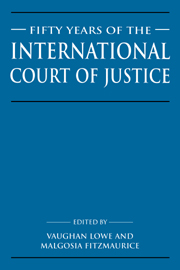Book contents
- Frontmatter
- Contents
- List of contributors
- Preface
- List of abbreviations
- Sir Robert Yewdall Jennings, by Vaughan Lowe
- List of publications of Sir Robert Jennings
- Table of cases
- Part I The International Court of Justice
- Part II The sources and evidences of international law
- Part III Substance of international law
- Part IV Procedural aspects of the work of the International Court of Justice
- 21 Procedural law and the International Court of Justice
- 22 The President of the International Court of Justice
- 23 Nationality of claims: some relevant concepts
- 24 The plea of domestic jurisdiction before the International Court of Justice: substance or procedure?
- 25 ‘Partial’ judgments and the inherent jurisdiction of the International Court of Justice
- 26 Intervention before the International Court of Justice
- 27 The use of Chambers of the International Court of Justice
- 28 The use of experts by the International Court of Justice
- 29 Provisional measures
- 30 Remedies in the International Court of Justice
- 31 A comment on the current health of Advisory Opinions
- Part V The International Court of Justice and the United Nations
- Index
27 - The use of Chambers of the International Court of Justice
Published online by Cambridge University Press: 02 November 2009
- Frontmatter
- Contents
- List of contributors
- Preface
- List of abbreviations
- Sir Robert Yewdall Jennings, by Vaughan Lowe
- List of publications of Sir Robert Jennings
- Table of cases
- Part I The International Court of Justice
- Part II The sources and evidences of international law
- Part III Substance of international law
- Part IV Procedural aspects of the work of the International Court of Justice
- 21 Procedural law and the International Court of Justice
- 22 The President of the International Court of Justice
- 23 Nationality of claims: some relevant concepts
- 24 The plea of domestic jurisdiction before the International Court of Justice: substance or procedure?
- 25 ‘Partial’ judgments and the inherent jurisdiction of the International Court of Justice
- 26 Intervention before the International Court of Justice
- 27 The use of Chambers of the International Court of Justice
- 28 The use of experts by the International Court of Justice
- 29 Provisional measures
- 30 Remedies in the International Court of Justice
- 31 A comment on the current health of Advisory Opinions
- Part V The International Court of Justice and the United Nations
- Index
Summary
INTRODUCTION
Many jurists, including Sir Robert Jennings and other members and former members of the Court, have extensively examined the history and use of Chambers of the Court and this chapter will avoid, where possible, the temptation to dress up in different language observations and arguments already made on the subject. Rather, it will focus on more recent developments in relation to Chambers. Additionally, the author will make personal observations on aspects of the subject which may or may not have attracted prior commentary.
This part of the chapter will briefly review the types of Chamber that the Court may form under its Statute. The second part will examine whether the advantages that its architects foresaw for the Chamber system have been realized in practice. The third part will address some of the criticisms that have been levelled against the institution of Chambers. Finally, the fourth part will analyse the nature and role of the standing Chamber that the Court has recently formed to deal with disputes concerning international environmental law.
The Statute provides for the creation of three different types of Chamber. First, under article 29, the Court is required annually to form a Chamber composed of five judges which may hear and determine a case, at the request of the parties, by summary procedure. A materially identical provision appeared in the same article of the Statute of the Court's predecessor.
- Type
- Chapter
- Information
- Fifty Years of the International Court of JusticeEssays in Honour of Sir Robert Jennings, pp. 503 - 527Publisher: Cambridge University PressPrint publication year: 1996
- 1
- Cited by



